
Gaspar de Witte (variations on his first name: Caspar, Jasper, and Jaspar) (bapt. 5 October 1624, Antwerp - 20 March 1681, Antwerp) was a Flemish painter who is known for his landscapes and gallery paintings.

Gaspar de Witte (variations on his first name: Caspar, Jasper, and Jaspar) (bapt. 5 October 1624, Antwerp - 20 March 1681, Antwerp) was a Flemish painter who is known for his landscapes and gallery paintings.
Gaspar de Witte was born in Antwerp as the son of Peter de Witte II en Barbara Remeeus. He was member of a prominent painting family. His father and his brothers Peter de Witte III and Jan Baptist de Witte were all painters. Gaspar was also the godchild of Gerard Seghers, an eminent history painter of Antwerp. [1] Gaspar de Witte trained with his father, who was specialized in landscapes, church interiors and religious paintings. [2]
Gaspar de Witte travelled to Rome in 1646 and joined the Bentvueghels, an association of mainly Dutch and Flemish artists working in Rome. It was the custom in the Bentvueghels to initiate new members and give them a nickname (the so-called bentname). Gaspar de Witte was given the nickname Grondel ("Gudgeon"). [3] The reason why he was named after this species of fish is not known. Around 1648 he is reported to have spent time in France. [1]
When he returned to Antwerp he became "winemaster" (used to denote the son of a master) in the Antwerp Guild of Saint Luke in 1650. [1] Gaspar de Witte also operated a small trading business in painting necessities. [1] His engraved portrait by the engraver Richard Collin after a painting by Anton Goubau was published in Cornelis de Bie's 17th century book on Flemish painters called Het Gulden Cabinet.
He was the teacher of Cornelis Huysmans and possible also of Adriaen Verdoel. [1] [4]

Gaspar de Witte is remembered for his landscapes and his collaborations with other artists on gallery paintings. [3]
His landscapes are similar to those of his contemporary landscape painters of Brussels. Most of them are not in the Italianate style then popular in Flanders but he often still included some Italian antique relics to respond to the prevalent taste in the local market. [5] His landscapes often included pastoral scenes with shepherds, religious scenes or genre scenes such as village fairs or dances. His landscapes often involved collaborations with other painters who painted the staffage. Four collaborations with Anton Goubau on Italianizing landscapes are recorded. [6]
In addition to imaginary landscapes he also produced a number of topographical views of country estates. These were often executed in collaboration with other painters who painted the staffage. An example is the View of Schoten Castle , which was a collaborative effort with Gonzales Coques. This composition shows a bird-eye view of Schoten Castle in Schoten painted by de Witte with two woman and a boy painted by Coques in the front right corner. Another example of a collaboration with Coques is the Portrait of Clara Rubens with Her Family , which shows Clara Rubens, the daughter of Peter Paul Rubens, with her family against a background landscape showing Merksem Castle. [7]

Gaspar de Witte was a collaborator in a few compositions belonging to the genre of the 'gallery paintings'. The 'gallery paintings' genre is native to Antwerp where Frans Francken the Younger and Jan Brueghel the Elder were the first artists to create paintings of art and curiosity collections in the 1620s. [8] Gallery paintings depict large rooms in which many paintings and other precious items are displayed in elegant surroundings. The earliest works in this genre represented art objects together with other items such as scientific instruments or peculiar natural specimens. The genre became immediately quite popular and was followed by other artists such as Jan Brueghel the Younger, Cornelis de Baellieur, Hans Jordaens, David Teniers the Younger, Gillis van Tilborch, Wilhelm Schubert van Ehrenberg and Hieronymus Janssens. The picture galleries depicted were sometimes real galleries. However, the majority were imaginary galleries, which sometimes included allegorical figures. [9]
An example of a gallery painting by Caspar de Witte is the Interior of an art collector's cabinet with many visitors, which is a collaboration with Hieronymus Janssens and Wilhelm Schubert van Ehrenberg. [10] The composition depicts an imaginary art gallery with many visitors who are appreciating and discussing some of the artworks in the gallery. This gallery painting represents a later development in the genre initiated by David Teniers the Younger that excluded non-art objects from the gallery. The figures in the gallery painting are portrayed as if they form part of an elite who possess a privileged knowledge, i.e. the ability to appreciate art. The genre of gallery paintings had by that time become a medium to accentuate the notion that the powers of discernment associated with connoisseurship are socially superior to or more desirable than other forms of knowing. [9]

Gaspar de Witte has been identified recently as the painter likely responsible for an allegorical gallery painting referred to as The allegorical female figures Nature and Pictura in an art-collection, with representative Antwerp canvasses . Rather than representing an actual depiction of a picture gallery with collectors, art dealers or famous painters this composition falls into the allegorical type of gallery painting as it places two allegorical figures in the gallery. The figure of Plenty on the left has beside her three putti bearing a cornucopia, symbolizing her largesse. Seated beside her is a personification of Pictura or Painting who is identified by the palette in her hands. The statues and books on the table and the musical instrument below refer to a wider embodiment of the Arts in general. The allegory was intended to be one of Peace or the effects of Peace since in the lower right hand corner of the gallery are the accoutrements of war, discarded in a pile. [11] The picture can also be regarded as an allegorical representation of the vanitas of worldly pursuits such as war which are transient in comparison to the arts and love, which endure for forever.
Gaspar de Witte was one of the collaborators in the gallery painting by Jacob de Formentrou referred to as Cabinet of pictures, currently in the Royal Collection. [12] It depicts a room full of pictures populated with human figures who are usually interpreted as representing art connoisseurs. The various pictures that are hung on the walls of the room represent works of leading mid-17th-century artists of Antwerp. [13] A cabinet of pictures depicts an imaginary gallery and can be seen as a summing up of the best of what artists in mid 17th-century Antwerp could produce. [14] It is believed that the pictures included in the composition were painted by each of the relevant artists. Gaspar de Witte is believed to have painted the landscape right of the door, signed G.D.WITTE. [15] The fact that de Witte was selected to participate in this collaborative effort demonstrates the esteem in which he was held by his fellow artists in Antwerp in his time.

Jan Brueghelthe Elder was a Flemish painter and draughtsman. He was the son of the eminent Flemish Renaissance painter Pieter Bruegel the Elder. A close friend and frequent collaborator with Peter Paul Rubens, the two artists were the leading Flemish painters in the first three decades of the 17th century.
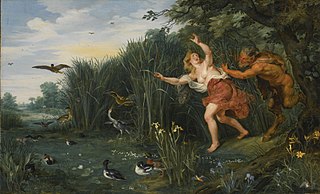
Jan Brueghelthe Younger was a Flemish Baroque painter. He was the son of Jan Brueghel the Elder, and grandson of Pieter Bruegel the Elder, both prominent painters who contributed respectively to the development of Renaissance and Baroque painting in the Habsburg Netherlands. Taking over his father's workshop at an early age, he painted the same subjects as his father in a style which was similar to that of his father. He regularly collaborated with leading Flemish painters of his time.

David Teniers the Younger or David Teniers II was a Flemish Baroque painter, printmaker, draughtsman, miniaturist painter, staffage painter, copyist and art curator. He was an extremely versatile artist known for his prolific output. He was an innovator in a wide range of genres such as history painting, genre painting, landscape painting, portrait and still life. He is now best remembered as the leading Flemish genre painter of his day. Teniers is particularly known for developing the peasant genre, the tavern scene, pictures of collections and scenes with alchemists and physicians.
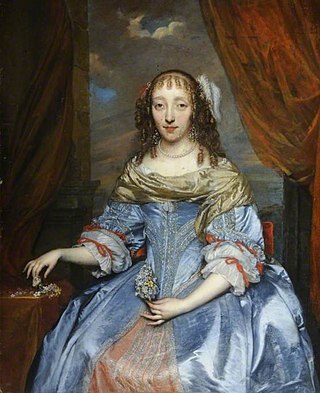
Gonzales Coques was a Flemish painter of portraits and history paintings. Because of his artistic proximity to and emulation with Anthony van Dyck he received the nickname de kleine van Dyck. Coques also worked as an art dealer.
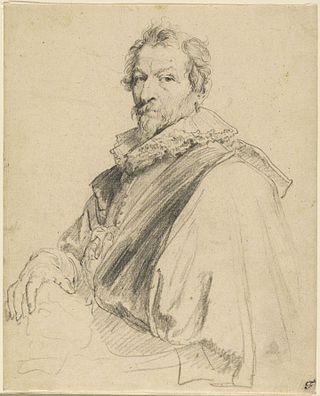
Hendrick van Balen or Hendrick van Balen I was a Flemish Baroque painter and stained glass designer. Hendrick van Balen specialised in small cabinet pictures often painted on a copper support. His favourite themes were mythological and allegorical scenes and, to a lesser extent, religious subjects. The artist played an important role in the renewal of Flemish painting in the early 17th century and was one of the teachers of Anthony van Dyck.
Gaspar Roomer was a prominent Flemish merchant, banker, art patron and art collector who was active in Naples in the 17th century.
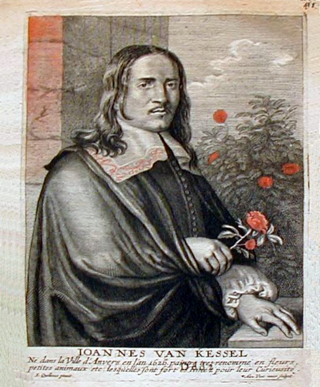
Jan van Kessel the Elder or Jan van Kessel (I) was a Flemish painter active in Antwerp in the mid 17th century. A versatile artist he practised in many genres including studies of insects, floral still lifes, marines, river landscapes, paradise landscapes, allegorical compositions, scenes with animals and genre scenes. A scion of the Brueghel family many of his subjects took inspiration of the work of his grandfather Jan Brueghel the Elder as well as from the earlier generation of Flemish painters such as Daniel Seghers, Joris Hoefnagel and Frans Snyders. Van Kessel’s works were highly prized by his contemporaries and were collected by skilled artisans, wealthy merchants, nobles and foreign luminaries throughout Europe.

Flemish Baroque painting refers to the art produced in the Southern Netherlands during Spanish control in the 16th and 17th centuries. The period roughly begins when the Dutch Republic was split from the Habsburg Spain regions to the south with the Spanish recapturing of Antwerp in 1585 and goes until about 1700, when Spanish Habsburg authority ended with the death of King Charles II. Antwerp, home to the prominent artists Peter Paul Rubens, Anthony van Dyck, and Jacob Jordaens, was the artistic nexus, while other notable cities include Brussels and Ghent.

Frans Francken the Younger was a Flemish painter who created altarpieces and furniture panels and gained his reputation chiefly through his small and delicate cabinet pictures with historical, mythological or allegorical themes. He is the best-known and most prolific member of the large Francken family of artists. Franckenplayed an important role in the development of Flemish art in the first half of the 17th century through his innovations in many genres including genre painting and his introduction of new subject matter. He was a frequent collaborator of leading Antwerp painters of his time.

Gillis van Tilborgh or Gillis van Tilborch was a Flemish painter who worked in various genres including portraits, 'low-life' and elegant genre paintings and paintings of picture galleries. He became the keeper of the picture collection of the governor of the Habsburg Netherlands and travelled in England where he painted group portraits.

Balthasar van den Bossche (1681–1715) was a Flemish painter who is mainly known for his wide range of genre subjects and occasional portraits.
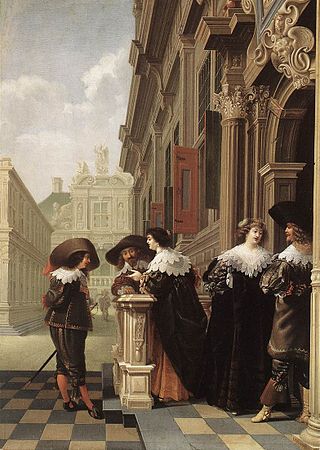
Dirck van Delen or Dirck Christiaensz van Delen was a Dutch painter who specialized exclusively in architectural paintings, principally depicting palace perspectives and church interiors.
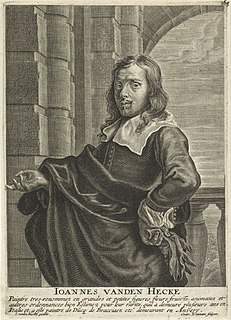
Jan van den Hecke or Jan van den Hecke the Elder (1620–1684) was a Flemish Baroque painter, draughtsman, printmaker and engraver, mainly known for his still lifes, landscapes and battle scenes. After training in Antwerp, he spent time in Rome, where he had important patrons. After his return to Flanders, he worked for a while in Brussels, probably painting flower still lifes for Archduke Leopold Wilhelm of Austria, the Austrian governor of the Spanish Netherlands, before returning to work in Antwerp.

Adriaen or Adriaan van Stalbemt or Adriaen van Stalbempt was a Flemish painter and printmaker who is known for his landscapes with religious, mythological and allegorical scenes. He was also a gifted figure painter who was regularly invited to paint the staffage in compositions of fellow painters.

Charles Emmanuel Biset or Karel Emmanuel Biset was a Flemish painter who had a peripatetic career working in various cities and countries including his hometown Mechelen, Paris, Annonay, Brussels, Antwerp and Breda. He worked in many genres including genre scenes of interiors with merry companies and gallery paintings, history painting, still life and portraiture.

Anton Goubau or Anton Goebouw was a Flemish Baroque painter. He spent time in Rome where he moved in the circle of the Bamboccianti, Dutch and Flemish genre painters who created small cabinet paintings of the everyday life of the lower classes in Rome and its countryside. He is known for his Italianate landscapes and genre paintings in the style of the Bamboccianti and his history paintings with mythological and religious themes.

Wilhelm Schubert van Ehrenberg or Willem Schubart van Ehrenberg (also: Wilhem Schubert von Ehrenberg or Wilhem Schubert van Ehrenberg was a Flemish painter mainly active in Antwerp who specialized in architectural paintings including of real and imaginary church interiors, Renaissance palaces and picture galleries.

Jacob de Formentrou or Jacob de Fourmentrou was a Flemish Baroque painter active in Antwerp who specialized in the genres of merry companies and gallery paintings.

Hieronymus Janssens or Jeroom Janssens was a Flemish genre painter known for his compositions depicting elegant companies engaging in dance, music or play, which were of influence on the development of the genre of the conversation piece. He also painted architectural scenes of real or imaginary palaces, churches, temples and art galleries.
Jan Baptist Tijssens the Younger (1660–1723) was a Flemish painter mainly known for his 'guardroom scenes' and still lifes. He was also active as an art dealer.